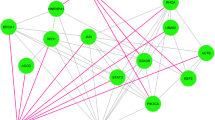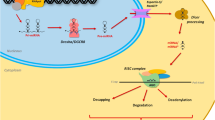Abstract
microRNA-9 (miR-9) has been found to be upregulated along with tumor progression of gliomas by microarray-based expression profiling, and also be strongly linked to glioblastoma subtypes. However, its prognostic value in glioma is still elusive. miR-9 expression in human gliomas and nonneoplastic brain tissues was measured by real-time quantitative RT-PCR assay. miR-9 expression in glioma tissues was significantly higher than that in corresponding nonneoplastic brain tissues (P < 0.001). The increased expression of miR-9 was more frequently observed in glioma tissues with high WHO grade than those with low WHO grade tissues (P = 0.001). The expression levels of miR-9 in glioma tissues with low Karnofsky performance score (KPS) were also significantly higher than those with high KPS (P = 0.008). Moreover, the overall survival of glioma patients with high miR-9 expression was obviously lower than that with low miR-9 expression (P < 0.001). Multivariate analysis further showed that high miR-9 expression was an independent prognostic factor for overall survival in glioma patients (P = 0.01). More importantly, the subgroup analyses indicated that the overall survival of glioma patients with high WHO grade (III–IV) was significantly worse for high miR-9 expression group than for low miR-9 expression group (P < 0.001), but no significant difference was found for patients with low WHO grade (I–II). These findings suggest for the first time that the increased expression of miR-9 may play an important role in tumor progression in human gliomas. miR-9 might be a useful marker for predicting the clinical outcome of glioma patients, especially for advanced subtypes.


Similar content being viewed by others
References
Rousseau A, Mokhtari K, Duyckaerts C (2008) The 2007 WHO classification of tumors of the central nervous system—what has changed? Curr Opin Neurol 21:720–727
Chu SH, Ma YB, Feng DF, Zhang H, Zhu ZA, Li ZQ, Jiang PC (2012) Correlation of low SLC22A18 expression with poor prognosis in patients with glioma. J Clin Neurosci 19:95–98
Louis DN, Ohgaki H, Wiestler OD, Cavenee WK, Burger PC, Jouvet A, Scheithauer BW, Kleihues P (2007) The 2007 WHO classification of tumours of the central nervous system. Acta Neuropathol 114:97–109
Zhang X, Yang H, Gong B, Jiang C, Yang L (2012) Combined gene expression and protein interaction analysis of dynamic modularity in glioma prognosis. J Neurooncol 107:281–288
Curran WJ Jr, Scott CB (1996) Radiosurgery for glioma patients: hope or hype? Int J Radiat Oncol Biol Phys 36:1279–1280
Esteller M (2011) Non coding RNAs in human disease. Nat Rev Genet 2011:861–874
van Kouwenhove M, Kedde M, Agami R (2011) microRNA regulation by RNA binding proteins and its implications for cancer. Nat Rev Cancer 11:644–656
Saal S, Harvey SJ (2009) microRNAs and the kidney: coming of age. Curr Opin Nephrol Hypertens 18:317–323
Rao SA, Santosh V, Somasundaram K (2010) Genome-wide expression profiling identifies deregulated miRNAs in malignant astrocytoma. Mod Pathol 23:1404–1417
Tang H, Yao L, Tao X, Yu Y, Chen M, Zhang R, Xu C (2013) miR-9 functions as a tumor suppressor in ovarian serous carcinoma by targeting TLN1. Int J Mol Med. doi:10.3892/ijmm.2013.1400
Sun Z, Han Q, Zhou N, Wang S, Lu S, Bai C, Zhao RC (2013) microRNA-9 enhances migration and invasion through KLF17 in hepatocellular carcinoma. Mol Oncol 7:884–894
Wang J, Zhao H, Tang D, Wu J, Yao G, Zhang Q (2013) Overexpressions of microRNA-9 and microRNA-200c in human breast cancers are associated with lymph node metastasis. Cancer Biother Radiopharm. (in press)
Saito Y, Saito H (2012) microRNAs in cancers and neurodegenerative disorders. Front Genet 3:194
Nass D, Rosenwald S, Meiri E, Gilad S, Tabibian-Keissar H, Schlosberg A, Kuker H, Sion-Vardy N, Tobar A, Kharenko O, Sitbon E, Lithwick Yanai G, Elyakim E, Cholakh H, Gibori H, Spector Y, Bentwich Z, Barshack I, Rosenfeld N (2009) MiR-92b and miR-9/9* are specifically expressed in brain primary tumors and can be used to differentiate primary from metastatic brain tumors. Brain Pathol 19:375–383
Krell J, Frampton AE, Jacob J, Pellegrino L, Roca-Alonso L, Zeloof D, Alifrangis C, Lewis JS, Jiao LR, Stebbing J, Castellano L (2012) The clinico-pathologic role of microRNAs miR-9 and miR-151-5p in breast cancer metastasis. Mol Diagn Ther 16:167–172
Zhu L, Chen H, Zhou D, Li D, Bai R, Zheng S, Ge W (2012) microRNA-9 up-regulation is involved in colorectal cancer metastasis via promoting cell motility. Med Oncol 29:1037–1043
Leucci E, Zriwil A, Gregersen LH, Jensen KT, Obad S, Bellan C, Leoncini L, Kauppinen S, Lund AH (2012) Inhibition of miR-9 de-represses HuR and DICER1 and impairs Hodgkin lymphoma tumour outgrowth in vivo. Oncogene 31:5081–5089
Zheng L, Qi T, Yang D, Qi M, Li D, Xiang X, Huang K, Tong Q (2013) microRNA-9 suppresses the proliferation, invasion and metastasis of gastric cancer cells through targeting cyclin D1 and Ets1. PLoS One 8:e55719
Liu N, Sun Q, Chen J, Li J, Zeng Y, Zhai S, Li P, Wang B, Wang X (2012) microRNA-9 suppresses uveal melanoma cell migration and invasion through the NF-κB1 pathway. Oncol Rep 28:961–968
Guo R, Wu Q, Liu F, Wang Y (2011) Description of the CD133+ subpopulation of the human ovarian cancer cell line OVCAR3. Oncol Rep 25:141–146
Gao F, Zhao ZL, Zhao WT, Fan QR, Wang SC, Li J, Zhang YQ, Shi JW, Lin XL, Yang S, Xie RY, Liu W, Zhang TT, Sun YL, Xu K, Yao KT, Xiao D (2013) miR-9 modulates the expression of interferon-regulated genes and MHC class I molecules in human nasopharyngeal carcinoma cells. Biochem Biophys Res Commun 431:610–616
Malzkorn B, Wolter M, Liesenberg F, Grzendowski M, Stühler K, Meyer HE, Reifenberger G (2010) Identification and functional characterization of microRNAs involved in the malignant progression of gliomas. Brain Pathol 20:539–550
Kim TM, Huang W, Park R, Park PJ, Johnson MD (2011) A developmental taxonomy of glioblastoma defined and maintained by microRNAs. Cancer Res 71:3387–3399
Ben-Hamo R, Efroni S (2011) Gene expression and network-based analysis reveals a novel role for hsa-miR-9 and drug control over the p38 network in glioblastoma multiforme progression. Genome Med 3:77
Sun J, Gong X, Purow B, Zhao Z (2012) Uncovering microRNA and transcription factor mediated regulatory networks in glioblastoma. PLoS Comput Biol 8:e1002488
Zhou X, Marian C, Makambi KH, Kosti O, Kallakury BV, Loffredo CA, Zheng YL (2012) microRNA-9 as potential biomarker for breast cancer local recurrence and tumor estrogen receptor status. PLoS One 7:e39011
Funding
This work was funded by National Natural Science Foundation of China (NO. 81272776).
Conflict of interest
None.
Author information
Authors and Affiliations
Corresponding authors
Rights and permissions
About this article
Cite this article
Wu, Z., Wang, L., Li, G. et al. Increased expression of microRNA-9 predicts an unfavorable prognosis in human glioma. Mol Cell Biochem 384, 263–268 (2013). https://doi.org/10.1007/s11010-013-1805-5
Received:
Accepted:
Published:
Issue Date:
DOI: https://doi.org/10.1007/s11010-013-1805-5




